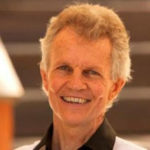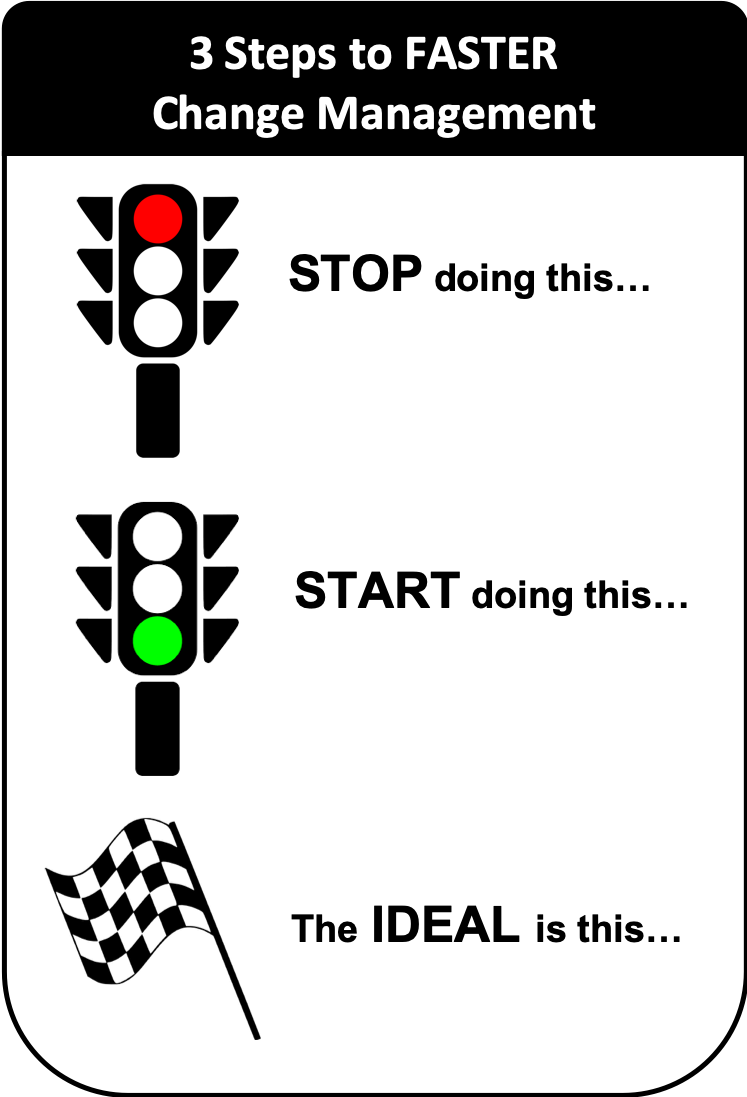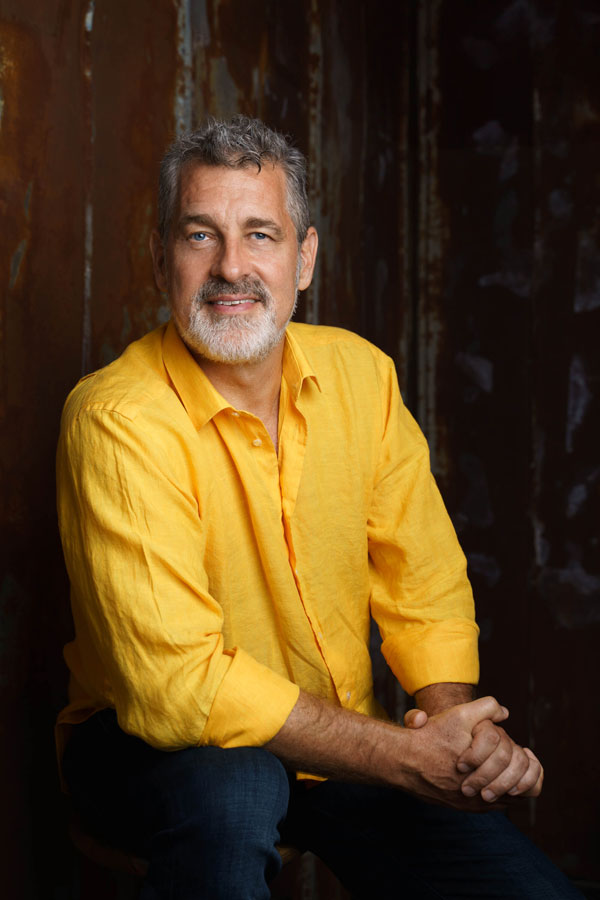Lead with Stop
Summary Insight:
If your team isn’t changing, it’s not a motivation problem—it’s a communication flaw. Use STOP-START-IDEAL to cut through inertia and drive real behavior change.
Key Takeaways:
- Change starts by calling out what must stop—first.
- Define what to start and model the ideal behavior clearly.
- Use the language of needs, not wants, to create urgency and alignment.
As a manager, have you found yourself asking an employee or team to do something differently and, despite your best attempts at getting through to them, their old behaviors remain? Does this not make you want to pull your hair out in frustration and consider a new career in bocce ball?
If you’ve answered even a half yes, you’re obviously not alone.
Often things go like this. You communicate to an employee or a team that something needs to change. You make sure to look for signs of shared understanding and commitment back from them: “Does what I’m saying make sense to you?” or “Can you repeat what I said back to me so I know that I was clear?” In that moment, they seem to get it. But when you follow up a few weeks later, you’re dismayed to find out that their old behaviors remain are stuck in place.
This scenario is as frustrating as it is common. The good news is there are approaches that can help you get the results you want with much less effort. I’m going to share a great one here that I learned recently from a wise mentor and coach.
The next time you find yourself in a similar situation, you can try this approach instead. Begin first by communicating what they need to STOP doing, then communicate what they need to START doing, and then paint a picture to define in unarguable terms what the IDEAL would look like.
If you can follow this sequence of STOP-START-IDEAL, your chances of initiating change and seeing new and positive behaviors is much greater. Why? Because each of us has finite energy in time. If you don’t first call out what existing behaviors or mindsets need to STOP, that person won’t likely have the energy and capacity to START something new. Finally, if you don’t create a shared consciousness about what the IDEAL or goal actually looks like, you may even lead the person in the wrong direction.
Let me illustrate the key differences between they typical approach to coaching and the STOP-START-IDEAL approach to coaching. We’ll start with an example from sports and then apply that understanding to a corporate setting.
The Blind Side
 Ben Jones is a hypothetical left tackle for the Jumbotron Jets. He has all of the physical tools and potential to be a great player but he isn’t performing at a high level. Despite the team’s best efforts at ensuring his success, he just doesn’t seem to get it.
Ben Jones is a hypothetical left tackle for the Jumbotron Jets. He has all of the physical tools and potential to be a great player but he isn’t performing at a high level. Despite the team’s best efforts at ensuring his success, he just doesn’t seem to get it.
It’s not from a lack of effort on Ben’s part either. Ben has clearly been working hard to get better. But at this point in his development, everyone — including Ben – is frustrated with his ongoing poor performance. It’s a real drag on the organization.
I’d like you to imagine that two of Ben’s coaches are on the line guiding him to practice his run blocking. Let’s listen in to the two approaches:
Coach 1: “Ok Ben, I want you to keep your body low and drive powerfully off the line, ready? Hut hut.”
“Damn it Ben, that’s not quick enough. You’re too far back in your stance. Do it again!!”
Coach 2: “OK Ben, I need you to first STOP shifting your weight back in your stance. Instead, I need you to START shifting your weight forward in your stance. Look, here is a picture of an IDEAL stance that I need you to model. Notice how far forward it is? Good, any questions? OK, ready, hut hut.”
“Nice Ben, you nailed it. That’s exactly right. Good job.”
What was the difference between these two coaches and their impact on Ben? The first coach told Ben what he wanted but it didn’t work because Ben’s existing behaviors and mindset were in the way. In order to be more successful, Ben first has to recognize and let go of what is taking up space in his behaviors and mindset. It’s not enough that others can see what Ben has to stop doing. It only matters that Ben gets it!
The second coach began by telling Ben what he needs to STOP doing. Only then could Ben fully understand what he needed to START doing. This coach also made sure that Ben could see and start to embody the IDEAL in his mind’s eye. It would be no surprise if Ben’s performance immediately started to improve.
Begin with STOP!
The second coach who followed the STOP-START-IDEAL model has a valuable insight and lesson for every manager struggling to coach up their staff. It’s the recognition that each of us has finite energy and capacity at any moment in time. If we don’t first identify and clear out what needs to stop happening, there’s no room or capacity in the employee to start a new, ideal mindset and behaviors. It’s true in athletics and it’s true in business.
Here’s an example from business. Let’s imagine you have an employee, Sam, who is the VP of New Business Development. Sam is charged with establishing new channel partnerships. He keeps closing mid-tier partnerships but he hasn’t yet closed one tier-one partnership, which is what the organization really needs him to do. You keep communicating, “Sam, it’s good that you’re closing these mid-tier partnerships but I want you to focus on tier-one partnerships too.”
What’s going to happen? Despite Sam putting some initial renewed efforts into closing tier-one partnerships, the inertia of mid-tier partnerships will continue because that is where Sam got initial traction and is comfortable operating. “Besides,” Sam tells himself, “at least it is something.” Inertia in life and business is a real thing.
Instead, you first need to make it clear to Sam what you need him to STOP doing. If he stops doing this, then that opens up space for that. If you don’t call out what he needs to stop doing first, the status quo will continue.
Now, you may be thinking: I can’t afford to have Sam stop doing mid-tier partnerships altogether because we need both. Well, that may indicate that you actually have a structural flaw if you are asking one person, Sam, to focus on both types of partnerships. Or it may mean that you need to stop spending outbound marketing efforts targeting mid-tier. Or it may mean that you have misaligned incentives for Sam. In any case, it won’t get fixed in Sam’s mind unless you communicate first that he needs to stop doing “X” in order to make space to start doing “Y,” and what an ideal “Y” actually looks like.
Followed by START, then the IDEAL
If you can clearly communicate what the employee needs to stop doing first, then it’s actually pretty easy to communicate what you need them to start doing, especially if you can show or model the ideal. Notice that this works for both actions and behaviors.
“Sam, I need you to stop calling mid-tier partners. I need you to start calling tier-one partners. An ideal tier-one partner is ACME which does $100M+ in sales, has 50+ distribution reps, and is the leading channel on the east coast. I need you to find 1 partner like ACME in each region within the next three months. Any questions?”
“Cindy, I need you to stop thinking like a department manager whose main goal is to build up and manage a team. I need you to start thinking like a subject matter expert instead. We already have an ideal model for this — think of Laura in the Business Alignment Office. Laura has just one staff member but she is a company resource to many people who seek her expertise.”
I’m not asking you to be formulaic with these examples, just to first call out what needs to STOP before you can communicate what needs to START happening, and then anchoring it in with an IDEAL model – in that sequence.
Who Should Define the Ideal?
In a normal scenario, you can rely on your staff to help define what an ideal looks like. In some cases, however, when you’ve been trying to communicate and you’re not getting results, it’s critical that you define the ideal. Why? Because if your employee really understood the ideal model, it’s likely that they would be doing it already. You have to define it for them and then make sure that they understand it clearly.
Needs, Not Wants
Notice in the examples that I’m using the language of needs and not wants. That’s deliberate. If the employee in question assumes that this is just the whim of you the manager and not a true need of the organization, it’s less likely that they will get it and actually change. It needs to be clear that this is a need, not a whim or desire. If these needs aren’t met, this employee is no longer going to be in this company or in this role. Got it?
What if They Still Don’t Change?
If you’ve tried this approach to change management and you’re still not getting results, then you need to either let the employee go or find a new role for them in the organization that is better suited to their skills, style, and interests.
In some cases, you’ll need to look deeper for any underlying structural flaws in your organization. If your employee or team is fighting an uphill battle in the structure, they won’t have the autonomy or resources to actually make the change you’re asking for.
Summary
The STOP-START-IDEAL communication model is based on the recognition that each of us has finite energy at any given moment in time. Before we can embrace a new behavior, especially a new behavior that’s a stretch to develop, we have to first cease doing what we’ve been doing, in mindset or behaviors, that is no longer effective.
If we can first get clear on what old behaviors or mindsets need to stop, and actually stop them, by law that frees up energy and capacity to develop new mindsets and behaviors. If we don’t first stop the old behaviors, the inertia of the status quo will continue.
First begin with STOP, then define the new behaviors to START, and then make sure to define what the IDEAL actually looks like. Do those steps in that sequence for better communications and more effective, faster change management.
Acknowledgements
 I always learn a lot from the people and coaches I work with. Here I want to give a shout out to a wise and talented conscious communications coach, Veda Mallory Ball of TeamWise. Veda is the person who taught me the STOP-START-IDEAL model and reminded me to align with my own first principles of Organizational Physics: first stop the leaks or energy drains that are stealing capacity. Thank you Veda for another great life lesson. To my readers, if your organization needs practical, heartfelt communication and management training, reach out to Veda. He’s a true sage.
I always learn a lot from the people and coaches I work with. Here I want to give a shout out to a wise and talented conscious communications coach, Veda Mallory Ball of TeamWise. Veda is the person who taught me the STOP-START-IDEAL model and reminded me to align with my own first principles of Organizational Physics: first stop the leaks or energy drains that are stealing capacity. Thank you Veda for another great life lesson. To my readers, if your organization needs practical, heartfelt communication and management training, reach out to Veda. He’s a true sage.




